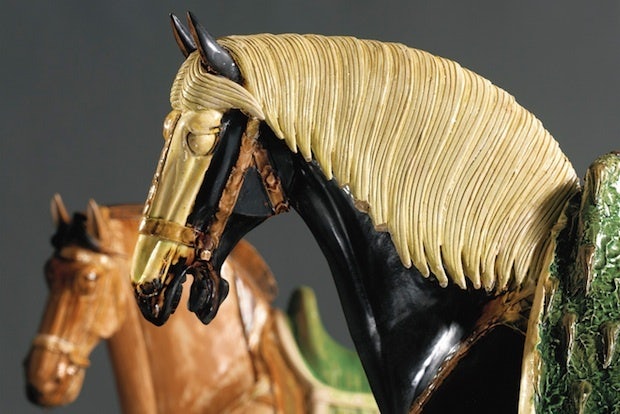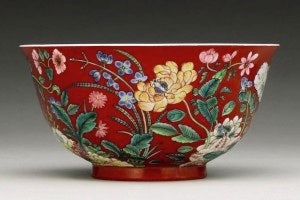
A close-up from a pair of sancai-glazed horses that sold at Sotheby's for $4.2 million, almost double their $2.5 million estimate. (Sotheby's)

A bronze figure of Parvati that sold for $963,750 at Christie's. (Christie's)
Asian art has been massively popular in this week’s New York auctions, with prices being driven well above even the high estimates for everything from ancient bronzes to Buddhist figures. Many of the antiques may be coming from Western collections, but collectors from China are making the highest bids this time around.
The rooms of the Asian art auctions held this week by top auction houses Christie's, Sotheby's, and Bonhams were filled to capacity, with mainly Chinese buyers in attendance. Thanks to a continued scarcity of art and the ever-growing Chinese buying power and interest in art and antiques, all three auction houses saw multiple sales at prices far above estimates. Fully aware of these trends, auction houses have been expanding payment options and working closely with banks in order to ensure greater ease in currency exchange and fund transfers for Chinese clients.
Christie’s Asian Art Week, which ends today, has had multiple successful sales with high prices attributed directly to Chinese bidders. The Indian and Southeast Asian Art sale brought in $9.2 million, with a bronze figure of Parvati from South India selling for $963,750 as its top lot. According to Hugo Weihe, the auction house’s head of Indian and Southeast Asian art, “the robust market for Buddhist art is underscored by new collectors actively bidding from China.” Meanwhile, all top 10 lots at the Fine Chinese Paintings sale not listed as “private” went to Asian buyers, with several works selling over their estimates to bring in a total of close to $10.5 million. Even Japanese and Korean art’s performance was attributed to Chinese buyers, according to Katsura Yamaguchi, Christie’s international director for Japanese and Korean art, who stated that Meiji period pieces “achieved strong prices due to active international participation across the board, from France to China to Mexico.”
Meanwhile, on September 16, Bonhams brought in $1.3 million for a rare Yongle bronze figure of Shadakshari Lokeshvara at its New York Chinese Art From the Scholar’s Studio auction, which sold for a stunning six times the original estimate. Many other pieces went beyond estimates as well, including a Ming dynasty incense burner, which sold for four times its pre-auction estimate at $326,500, and a Tang dynasty pottery figure that tripled its pre-auction estimate to sell for $182,500. In addition, classical and 20th century Chinese paintings also performed well, as did huanghuali antique furniture, which is especially popular with Chinese buyers.
In an interview with China Daily, Bruce MacLaren, senior specialist for Chinese art at Bonhams New York, also attributed the success of the sales directly to Chinese buyers:
"[The demand for Chinese art] is largely due to China's economic growth in the last 10 years," MacLaren said. "There are many more Chinese buyers participating in the market, a result of tremendous new wealth in China." About 80 percent of the registrants at this auction were from China, he said.
In addition, Chinese bidders are willing to spend far more than Western buyers on Asian art, which is not only why they are winning the lots, but also why the prices are going above estimates in many cases:
There is interest from Western collectors and dealers, but MacLaren said that they're often "getting priced out". Chinese buyers are willing to bid aggressively for pieces, which causes certain pieces of art to sell at much higher prices than they sold for in the past.

A Yongzheng coral-ground famille rose floral bowl that sold for $905,000 at Sotheby's. (Sotheby's)
Sotheby’s Asian art sales also did quite well, with its Fine Chinese Ceramics and Works of Art auction on September 17 and 18 bringing in almost $40 million. The second day came in well above the estimate at $22.7 million, with a pair of sancai-glazed pottery horses leading the sale at close to $4.2 million, much higher than the $2.5 million estimate. In addition, a Yongzheng floral bowl made $905,000, far above the high estimate of $600,000. Meanwhile, a sale of ancient bronzes at a separate sale netted prices well above estimates as well, with a Shang dynasty wine vessel rising to $1.9 million, far above its high estimate of $500,000, and a Zhou dynasty ritual vessel going for $605,000 after a $120,000 estimate.
The immense growth in number of Chinese buyers in the art market, who have the funding and ambition to bid far above Western buyers, is leading to an unofficial “repatriation” of a massive number of antiques back to China. For example, all top 10 lots in Christie’s Fine Chinese Paintings sale were from U.S. collections, but many will most likely be making their way back to China with the number of buyers listed from Asia. The idea of antique repatriation has been a matter of national pride for both Chinese bidders and the Chinese government, which is highlighted most prominently whenever pieces from a set of 12 Qing dynasty zodiac heads looted by the British from the Yuanmingyuan Summer Palace in 1860 come to the auction block. The most recent pair to return to China were donated by Christie’s owner François-Henri Pinault this spring after a major controversy occurred when Christie’s tried to sell them at auction in 2009.